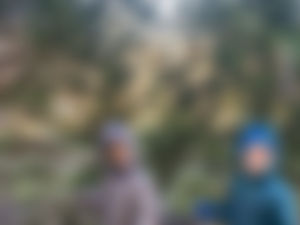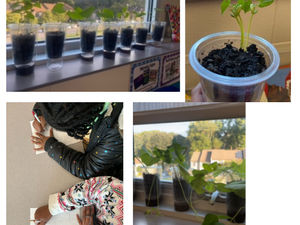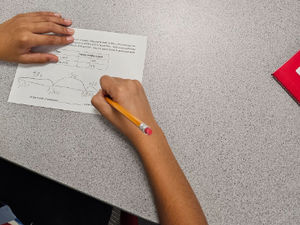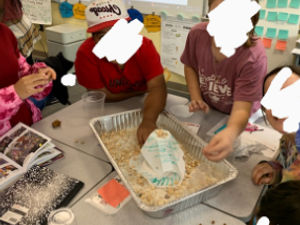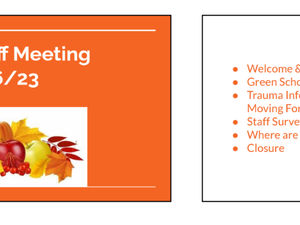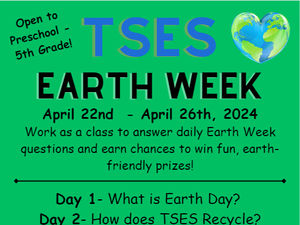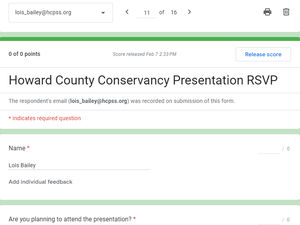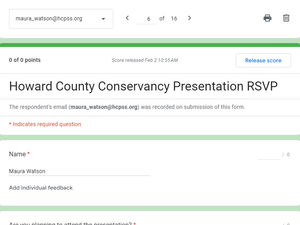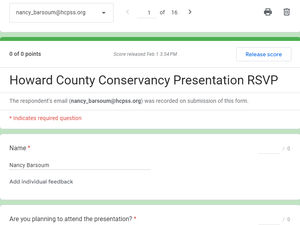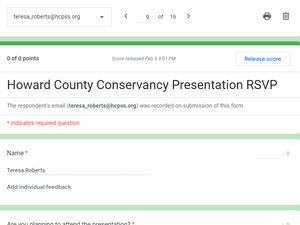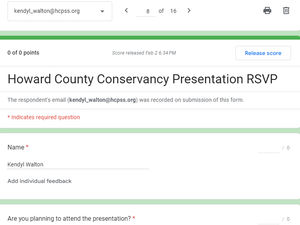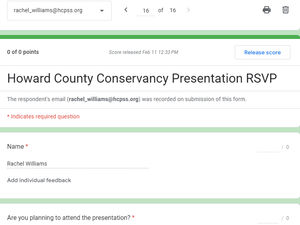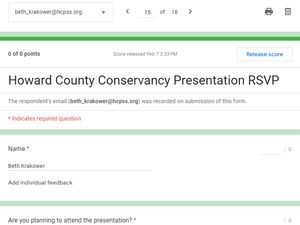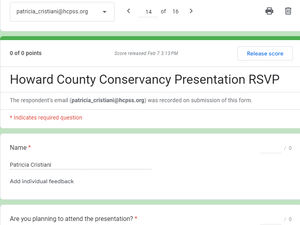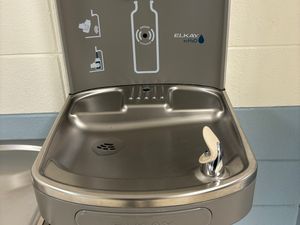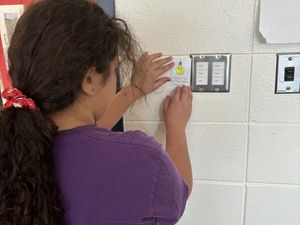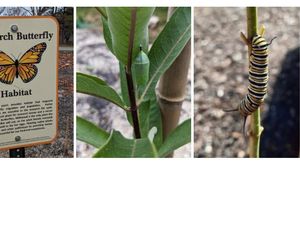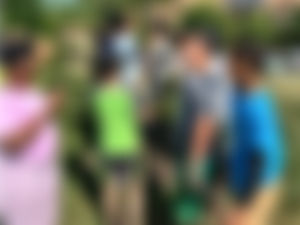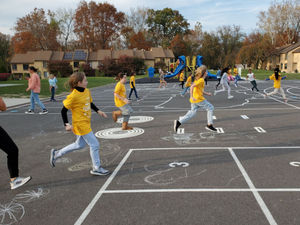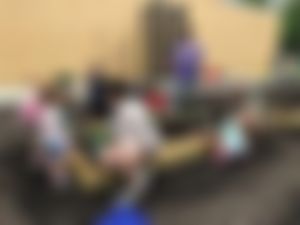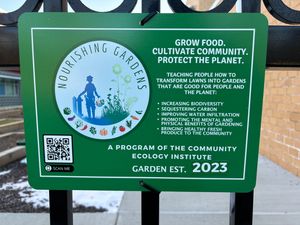Systemic Sustainability
Environmental Curriculum and Instruction
1.1 Curriculum and Instruction
Elementary & middle schools must provide one example of outdoor/environmental instruction per grade level.
High schools must provide one example of outdoor/environmental instruction in four subjects (which may include multiple different differents sciences).
On December 15th, Kindergarten students made bird feeders to hang in the trees outside their classroom windows. This was an extension of the Kindergarten Science Unit about what animals need to live and grow. In the classroom they completed a journal entry to show what animals need. Observation of the bird feeders gave the students an opportunity to see the birds get what they need to survive.
First grade students went on a field trip to the Howard County Conservancy in Woodstock, MD. On this trip, they learned about nature by going on a hike. They also learned about wildlife by listening to a lecture about owls and saw an owl that the Conservancy rescued. Students walked around the grounds and found insects, leaves, bark, etc. to observe and look at through magnifying glasses.
All 69 second grade students participated in releasing Painted Lady Butterflies after making observations and learning about pollination in our science unit.
Third grade students planted green bean seeds and observed them through the growth process. We were very excited this year because we were able to grow large vines. Students were very excited to observe the life cycle of a seed they had planted. We continued to use our observation skills into the cold weather months.
Our school has water bottle filling stations at each water fountain. As part of a math lesson that was a review of subtraction with regrouping, 64 Fourth Grade students calculated the number of plastic water bottles saved during the month of November.
5th grade students utilized their knowledge of a geosphere and aspects of a geosphere to create a geosphere watershed model. This model was then used to show the interactions of Earth's systems and what humans can do to prevent pollution in our waterways.
Students learned about recycling and reusing. The students learned about the importance of recycling and its effects on the environment. This involved turning the housekeeping center into a recycling plant. The kids helped to make labels for a few boxes and covered the boxes with the recycling colors. The kids brought in different items to be recycled from their homes and learned how to sort the different items into boxes. They also learned about the different symbols on plastic products and sorted according to the numbers on the items. Students then learned about reusing things instead of throwing them away and made different instruments from recycled materials.
1.2 Green School Awareness
1.2.1 School Wide Awareness - Staff
Demonstrate that all school personnel are aware of your school's Green School status and application process.
At a staff meeting on November 6, 2023, all staff was informed that we are reapplying for our Green School Certification. The Green School Committee reminded the staff that they will be asking for participation across grade levels. More information will be distributed during the course of the year. They were encouraged to contact any of the committee member if they have any questions.
At a staff meeting on November 6, 2023, all staff was informed that we are reapplying for our Green School Certification. The Green School Committee reminded the staff that they will be asking for participation across grade levels. More information will be distributed during the course of the year. They were encouraged to contact any of the committee member if they have any questions.
1.2.2 School-Wide Celebration
Demonstrate how your school celebrates beig a Green School by hosting a school-wide environmentally-focused event open to all students.
Talbott Springs will be celebrating Earth Day/week in April. Each day classrooms will be learning about different ways our school is helping our environment. Students will also be generating new ideas to implement in the future. Each day classes will be asked to complete a digital survey to share what they learned. Prizes will be awarded for classes that participate. 491 students will participate in this celebration.
In April 2024, Talbott Springs will be celebrating Earth Week with daily mini-lessons presented in each classroom Preschool-5th grade. Classes will be challenged to respond to daily questions about each topic. Participating classes will be entered into a raffle to win fun, earth-friendly prizes. Some of the prizes include nominating a teacher to dye their hair green, watering the garden for a week, and a party with food harvested from our garden.
Earth Week advertisement that will be sent out to staff and students prior to our Earth Week celebration.
Earth Week at TSES Slides (8.86 MB)
Slideshow that teachers will share with the students each day.
Environmental Professional Development for Teachers
1.3.1 Environmental Professional Development for Teachers
Demonstrate that 10% of staff have completed an environmental PD. Instructional staff is defined as any staff that manages a gradebook.
- New Schools must have all PD completed within the past 2 academic years.
- Renewing schools must have all PD completed within the past 4 academic years.
A teacher who has participated in multiple workshops may only be counted once..
On February 12, 2014, Talbott Springs invited Teddy Driscoll to provide professional development for our staff. Mr. Driscoll is the Elementary Programs Manager for the Howard County Conservancy. Mr. Driscoll presented a program entitled "Stories from the Garden" to 16 staff members. During the program we learned about how to incorporate interpretive storytelling in our lessons. He modelled a lesson and then gave us time to practice in small groups. We were encouraged to use our school garden to allow students to explore, discover and learn through interpretive storytelling.
Invite sent to staff:
On Monday, February 12th at 3:30pm, we will have an optional presentation put on by the Howard County Conservancy. It won't be longer than 45 minutes. If you would be willing to attend, please fill out the google form linked here.
Invite sent to staff:
On Monday, February 12th at 3:30pm, we will have an optional presentation put on by the Howard County Conservancy. It won't be longer than 45 minutes. If you would be willing to attend, please fill out the google form linked here.
Invite sent to staff:
On Monday, February 12th at 3:30pm, we will have an optional presentation put on by the Howard County Conservancy. It won't be longer than 45 minutes. If you would be willing to attend, please fill out the google form linked here.
Invite sent to staff:
On Monday, February 12th at 3:30pm, we will have an optional presentation put on by the Howard County Conservancy. It won't be longer than 45 minutes. If you would be willing to attend, please fill out the google form linked here.
Invite sent to staff:
On Monday, February 12th at 3:30pm, we will have an optional presentation put on by the Howard County Conservancy. It won't be longer than 45 minutes. If you would be willing to attend, please fill out the google form linked here.
Invite sent to staff:
On Monday, February 12th at 3:30pm, we will have an optional presentation put on by the Howard County Conservancy. It won't be longer than 45 minutes. If you would be willing to attend, please fill out the google form linked here.
Invite sent to staff:
On Monday, February 12th at 3:30pm, we will have an optional presentation put on by the Howard County Conservancy. It won't be longer than 45 minutes. If you would be willing to attend, please fill out the google form linked here.
Invite sent to staff:
On Monday, February 12th at 3:30pm, we will have an optional presentation put on by the Howard County Conservancy. It won't be longer than 45 minutes. If you would be willing to attend, please fill out the google form linked here.
1.4 Achieving Sustainable Schools
1.4.1 School-Wide Staff Sustainability
Demonstrate the sustainability practices your teachers, staff, and other personnel have implemented school-wide to make your school green. Any actions involving students belong under Objective 2.
Our school has installed 4 water fountains equipped with water bottle fillers. The fountains keep track of the number of plastic water bottles saved. This encourages students and staff to use refillable water bottles.
1.4.2 Systemic Partnership
Demonstrate one partnership with a central office or board within the school system that supports part of the Maryland Green Schools Program. Any partnerships outside of your school system belong under Objective 3.
The Howard County Public School System Elementary Science Office has collaborated with HCPSS educators, as well as those from other school systems, community volunteers, scientists, and Monarch organizations to support the successful rearing of Monarch butterflies in the classroom. Our school participated in this program.
Student Action
Schools must document eight total actions that address at least three of the listed sustainability practices.
These are student actions not adult actions. Adult sustainable actions can be documented in Objective 1.4.
2.1 Water Conservation/Pollution Prevention
2.1 Water Conservation/Pollution Prevention
Students use two installed rain barrels to water the school vegetable garden. They learn how the rain barrel collects water off the roof and how it helps us use less water from the school water sources.
2.2 Energy Conservation
2.2 Energy Conservation
In celebration of National Energy Conservation Day, students in 4th grade decorated signs to hang up in each classroom. The signs encourage everyone to turn off the lights when they leave the room.
2.3 Solid Waste Reduction
2.3 Solid Waste Reduction
Throughout the school, students collect paper waste. This paper is then collected in a large bin in the hallway. Next it is place in a large dumpster that is emptied weekly.
Every Friday, students collect food scraps from the school cafeteria and teacher's lounge and add them to our compost bin located in our vegetable garden area.
2.4 Habitat Restoration
2.4 Habitat Restoration
We installed and maintain a Monarch Butterfly Habitat. We also have native perennial plants in our garden that attract insects. Students observe evidence of Monarchs during the course of the summer. There is a direct connection for the 3rd graders who participate in a Monarch Butterfly unit.
2.5 Opportunities for Nature Exploration
2.5 Opportunities for Nature Exploration
Students use our Outdoor Classroom when participating in Science investigations. It is also used for other content areas. Students who need a break from their traditional learning classrooms also benefit from using this space.
Our Vegetable Garden provides opportunities for student participation. They help plant, maintain and harvest. Many of the primary students also use this space to build vocabulary by identifying colors, flowers, vegetables, etc. The produce from the garden is shared with school families and our local community.
2.6 Responsible Transportation
2.6 Responsible Transportation
No records were added by the school.
2.7 Healthy Indoor Environments
2.7 Healthy Indoor Environments
All 3rd - 5th grade girls are invited to participate in Girls on the Run. There is a fall session and a spring session. The group meets twice a week to help students recognize their inner strength, increase their level of physical activity, imagine their possibilities, and confidently stand up for themselves and others.
2.8 Citzen/Community/Participatory Science
2.8 Citizen/Community/Participatory Science
No records were added by the school.
Community Partnership
Demonstrate that your school is forming long-term partnerships to foster environmental stewardship and cultivate community wellness through real-world connections.
3.1 Community Partnerships
3.1.1 School Active in Community
Describe at least one environmentally-focused partnership in which your school is working to benefit your community.
Over the summer, produce from our Vegetable Garden is donated to an organization called Columbia Community Care. This is a local organization that distributes food to community members.
3.1.2 Community Active in the School
Describe at least one partnership in which a community partner is benefitting the school. These actions and projects occur on or near school grounds with support from the partner.
We have established a partnership with a Community Ecology Institute. This is a local organization that supports our Community Vegetable Garden. They have provided advice, garden planning, garden materials and volunteers to make sure our garden is successful.
This is a photo of our work day in the Spring of 2023. Community Ecology Institute Nourishing Gardens Program provided many of the materials. Volunteers from the school community as well as Master Gardeners participated.
This is another photo of the Spring Planting Event that was supported by the Community Ecology Institute's Nourishing Gardens Program.
This sign at the entrance to our garden informs visitors that it was built in partnership with Columbia Ecology Institute's Nourishing Gardens Program.
3.2 Additional Achievements
3.2 Additional Achievements optional
Share any environmentally-related awards, special recognition, certifications, or other achievements that your school, staff or students have accomplished.
